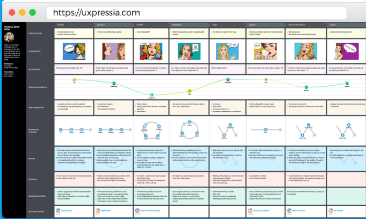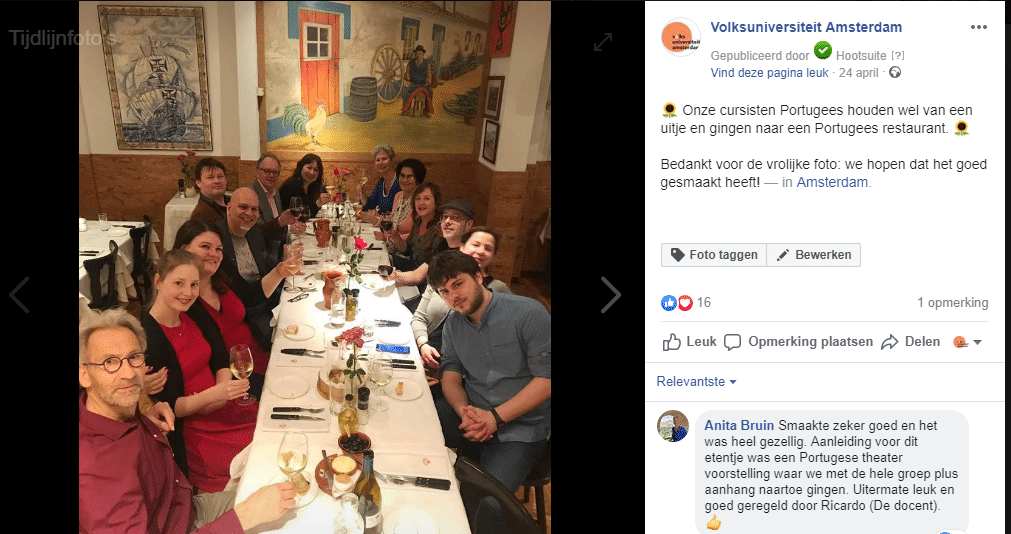on Thursday July 4, 2019
Er Was Eens… Een Jonge Vrouw uit Amsterdam
Customer Journey Mapping in 4 stappen
Er was eens… een jonge vrouw uit Amsterdam, haar naam is Anna. Anna is een spontane vrouw van 33, al een stukje verder in haar carrière en altijd op zoek naar manieren om zichzelf te ontwikkelen. Dit is het verhaal van Anna, die na een lange zoektocht toch Sophie bleek te zijn.
Anna staat voor de grote groep vrouwelijke binnenstedelijke jongvolwassenen (25-40) in Amsterdam. Een snel groeiende doelgroep en daarmee interessant voor veel aanbieders. Onze klant Volksuniversiteit Amsterdam biedt een breed aanbod cursussen en workshops, onder andere op het gebied van talen en persoonlijke ontwikkeling.
Volksuniversiteit Amsterdam wil het cursusaanbod beter onder Anna’s aandacht brengen. Om dit te realiseren is echte kennis van de doelgroep nodig: wat zijn de interesses en behoeftes van Anna? Alleen door Anna goed te leren kennen is helder te krijgen waar het aanbod aangepast moet worden en op welke manier Volksuniversiteit Amsterdam het beste met Anna in contact kan komen. In welke kanalen liggen nieuwe kansen en waar wordt Anna al goed bediend?
In Google Analytics zagen we dat de website van Volksuniversiteit Amsterdam al goed bezocht wordt door bezoekers als Anna. Om te bepalen hoe we zoveel mogelijk Anna’s in de schoolbankjes kunnen krijgen, adviseerden we Volksuniversiteit Amsterdam om samen met ons het avontuur van Customer Journey Mapping aan te gaan.
We splitsen de ideale klantreis van Anna op in 7 delen:
- 1. Ik besef dat ik nieuwe kennis of vaardigheden wil leren
- 2. Ik ga op zoek naar opties om dit te realiseren
- 3. Ik vergelijk verschillende aanbieders
- 4. Ik kies voor een cursus bij Volksuniversiteit Amsterdam en schrijf me in
- 5. Ik volg de cursus
- 6. Ik vond de cursus leuk en volg vaker een cursus bij Volksuniversiteit Amsterdam
- 7. Ik raad Volksuniversiteit Amsterdam aan bij vrienden en bekenden
Waarom is het eigenlijk zo belangrijk om de verschillende fases van de klantreis zo compleet in beeld te brengen? Als je goed kijkt, begrijp je dat Anna bij ieder punt gebruik maakt van andere kanalen en per punt een ander doel heeft. Het zoeken naar manieren om iets nieuws te leren zal Anna bijvoorbeeld op een andere manier doen dan het aanraden van Volksuniversiteit Amsterdam aan vrienden en bekenden. Wanneer je deze kanalen en doelen goed in beeld hebt, kun je Anna overal goed helpen met de stappen die ze wil nemen.
De geboorte van Anna
Anna werd geboren na het in kaart brengen van onze interne kennis en die van de klant en het bestuderen van bestaande materialen over de doelgroep. Wat wisten we al van de jongvolwassen, binnenstedelijke vrouw uit Amsterdam? Wat houdt haar bezig, wat motiveert haar, wat wil zij nog leren? We kregen zo een beeld van onze persona, die we de werknaam Anna gaven.
De volgende stap was het invullen van de klantreis. We noteerden alle aannames over de stappen die Anna neemt voordat zij een cursus afrondt en deze aanraadt aan anderen. Hiervoor gebruikten we de online tool van UXPressia, dat het mogelijk maakt om persona’s te creëren, de customer journey aan te maken en te visualiseren, en de verschillende touchpoints te analyseren.
voorbeeld van een Customer Journey Map in UXPressia:

Nu we Anna en haar verwachte klantreis in kaart hadden gebracht, was het tijd om onze aannames aan de praktijk te toetsen.
In gesprek met Anna
Dit is voor ons het meest inspirerende deel van Customer Journey Mapping: het daadwerkelijk spreken met de doelgroep. Tegelijk kan het ook een grote uitdaging zijn: want hoe krijg je Anna te spreken? Zij heeft het druk met haar werk en sociale leven, heeft zij wel tijd om zich door ons het hemd van het lijf te laten vragen?
We besloten om 7 bestaande klanten van Volksuniversiteit Amsterdam en 7 non-klanten uit de doelgroep te interviewen. We nodigden de doelgroep uit via reclame in Facebook, per mail, via de nieuwsbrief en directe berichten in LinkedIn. Ons verzoek was niet gering: we verzochten deelnemers om naar ons toe te komen en zich een uur lang te laten interviewen over allerhande onderwerpen.
We waren opgelucht toen de aanmeldingen al vrij snel binnen stroomden. We spraken uiteindelijk zelfs 15 deelnemers en hadden nog aanmeldingen op de reservelijst staan. De aangeboden kortingsbon voor een cursus vonden de deelnemers een leuk gebaar, maar was geenszins de reden om deel te nemen. Stuk voor stuk gaven onze deelnemers aan Volksuniversiteit Amsterdam graag te helpen om het cursusaanbod beter voor het voetlicht te brengen.
Voor het maken van een script voor de interviews baseerden we ons op de klantreis van Anna. Voor elke stap in de reis bedachten we vragen die inzichten, nieuwe mogelijkheden en pijnpunten aan het licht konden brengen.
Een belangrijke tip voor iedereen die overweegt om bezig te gaan met Customer Journey Mapping is om het script voor de interviews altijd eerst te testen op een collega en ook op de klant zelf! Assumptions are the mother of all failures, en vragen blijken altijd op verschillende manieren geïnterpreteerd te kunnen worden. Een regel die wij bij Orange Bird Agency altijd in het achterhoofd houden!
Het afnemen van de interviews is hard werken: maar wat geeft het een energie en inspiratie om de doelgroep live te spreken!
Anna wordt Sophie
Bewapend met al onze nieuwe kennis stelden we in de tool van UXPressia een realistisch profiel van onze persona op en vulden we haar daadwerkelijke klantreis in. De persona leek wel op Anna, maar week op belangrijke punten ook af. Anna verdiende een nieuwe naam: we noemden haar Sophie.
We kennen Sophie van haver tot gort: we weten welke behoeftes zij heeft, wat ze in haar vrije tijd doet en hoe ze gebruik maakt van sociale media. Sophie voelt als een vriendin die af en toe over onze schouder meekijkt en ons de juiste richting op stuurt wanneer we even vastzitten.
Bij het vastleggen van de touchpoints tijdens de klantreis en het identificeren van de pijnpunten hoorden we naast zaken die we al verwachten, ook verrassende nieuwe inzichten. Uiteraard kunnen we niet meteen alle verbeterpunten oppakken. Ons advies is om eerst het laaghangende fruit aan te pakken. De projecten die meer tijd in beslag nemen kunnen ingepland worden op volgorde van belangrijkheid: welke kosten komen erbij kijken en wat zijn de verwachte resultaten?
Een voorbeeld van laaghangend fruit voor Volksuniversiteit Amsterdam is de omschrijving per cursus op de website. Sophie wil graag weten welke methodes en middelen tijdens de cursus worden gebruikt en wat zij zal kunnen met de kennis die zij in de cursus opdoet. Dit soort informatie zal in de nieuwe cursus-omschrijvingen dan ook niet ontbreken.
De respondenten hebben veel nieuwe kanalen voor het adverteren voorgesteld. De nieuwe inzichten helpen ook bij het gerichter adverteren in de bestaand kanalen en bij het posten op sociale media. Sophie heeft het vaak druk. Eén van de redenen die Sophie noemde om zich niet in te schrijven voor een cursus is dan ook gebrek aan tijd. Volksuniversiteit Amsterdam speelt daar nu op in door op sociale media te laten weten dat er ook korte workshops zijn, of lezingen en wandelingen.
Sophie twijfelt ook aan de groepsgrootte en samenstelling van de cursussen: is er wel genoeg individuele aandacht? In plaats van alleen te vertellen hoe groot de groepen zijn en wie er deelnemen, kiezen we er namens Volksuniversiteit Amsterdam voor om vaker foto’s van de cursisten op sociale media te plaatsen:

Naast het laaghangende fruit zijn er meer vruchten te plukken. Dit kost meer tijd, inzet en budget. Zo bleek bijvoorbeeld dat Sophie veel via via aan informatie komt over interessante cursussen. Dit kan rechtstreeks tijdens een gesprek zijn, maar nog vaker wordt deze informatie gedeeld via sociale media.
Sophie loopt er bij Volksuniversiteit Amsterdam tegenaan dat zij haar ervaring niet gemakkelijk kan delen: er is bijvoorbeeld op de website of in de mail geen share button voor WhatsApp en Facebook. Ook krijgen cursisten geen uitnodiging om hun ervaringen te delen door bijvoorbeeld een online review te plaatsen.
Volksuniversiteit Amsterdam loopt zo een hoop aanbevelingen en daarmee potentiële inschrijvingen mis: de vriendinnen van Sophie krijgen simpelweg niet te horen welke interessante cursussen zij kunnen volgen. Het vraagt om investeringen om stap 7 van Sophies klantreis: “Ik raad Volksuniversiteit Amsterdam aan bij vrienden en bekenden” te vergemakkelijken.
Ook bleek duidelijk uit de interviews dat Sophie haar zoektocht naar een geschikte cursus 9 van de 10 keer op Google begint. Sophie is een kritische Internetgebruiker en vertrouwt meer op de organische resultaten dan op de getoonde advertenties. Eén deelnemer zei letterlijk “Ik klik nooit op resultaten waar ‘advertentie’ voor staat, ik scrol altijd door naar de eerste gratis resultaten.” Dit inzicht heeft Volksuniversiteit Amsterdam doen besluiten om in de nabije toekomst nog sterker op SEO in te zetten.
Verder kregen we waardevolle inzichten over hoe we de website en het inschrijfproces kunnen verbeteren. Ook legden we nieuwe concepten en ideeën van Volksuniversiteit Amsterdam aan de deelnemers voor, zodat we meteen wisten waar Sophie wel en niet warm voor zou lopen. De lijst met inzichten is te lang om hier helemaal uit de doeken te doen: we zijn al onze deelnemers voor eeuwig dankbaar voor de inzichten die zij ons hebben gegegeven!
En ze leefden nog lang en gelukkig
Volksuniversiteit Amsterdam en Sophie gaan samen een mooie toekomst tegemoet. Dankzij Sophie kan Volksuniversiteit Amsterdam écht klantgericht werken.
Wij, als marketeers, willen onze klant hiermee helpen: Volksuniversiteit Amsterdam ging akkoord met ons voorstel om voor elk stadium van de klantreis een set KPI’s vast te leggen. Deze KPI’s documenteren en analyseren we per maand. Op deze manier kunnen we ons werk beoordelen door de ogen van Sophie, zodat wij haar in elke stap van haar klantreis kunnen helpen door haar van de juiste informatie te voorzien.
Alleen is ook maar alleen, daarom zullen we in de nabije toekomst een paar vrienden voor Sophie opzoeken. We gaan voor Volksuniversiteit Amsterdam nog een aantal persona’s en hun klantreis in kaart brengen. We verwachten dat ook zij ons van veel waardevolle informatie zullen voorzien.
Wij zouden elk bedrijf dat écht klantgericht wil werken aanraden om ook het avontuur van Customer Journey Mapping aan te gaan. De inzichten die dit oplevert helpen om de klant en zijn behoeften compleet te doorgronden. Het zorgt ervoor dat je in iedere fase van de klantreis op de juiste manier te vinden bent: op je website, op sociale media, in advertenties.
Wil jij ook écht klantgericht gaan werken door de klantreizen voor jouw bedrijf in kaart te brengen? Neem contact met ons op, onze kennis is up-to-date en we denken graag met je mee!
Previous postNext post


